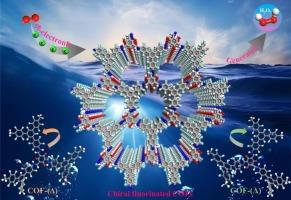手性记忆引导下在海水中高效光催化过氧化氢合成氟化共价有机框架的构建
IF 13.2
1区 工程技术
Q1 ENGINEERING, CHEMICAL
引用次数: 0
摘要
由于海水的高盐度、复杂的污染物和快速的电荷载流子重组,传统的光催化剂在实现高效、稳定的H2O2合成方面面临挑战。本文通过(R/S)-1-苯乙胺和2,4,6-三甲酰间苯三酚的精确缩合,提出了手性氟化共价有机框架(PETG-COF-(Δ/Λ))。PETG-COF-(Δ)在可见光照射下在海水中产生H2O2的速率为4967 μmol·g−1·h−1,比非手性产物提高了2.3倍。实验结果和理论计算表明,Δ-configured手性框架通过优化反应物和中间体的吸附构型,并通过手性微环境固有的不对称电场促进电荷载流子的快速迁移,提高了2e−氧还原反应(ORR)的性能。值得注意的是,氟化不仅扩大了光吸收,而且还产生了疏水通道和钝化层,有效地阻止了Cl -腐蚀,并确保在流动反应器中活性保持在66 h以上。本研究为太阳能驱动手性COFs合成H2O2开辟了新的途径,为设计适应海水的光催化体系提供了理论基础。本文章由计算机程序翻译,如有差异,请以英文原文为准。

Chiral memory-guided construction of fluorinated covalent organic frameworks for efficient photocatalytic hydrogen peroxide synthesis in seawater
Conventional photocatalysts face challenges in achieving efficient and stable H2O2 synthesis from seawater due to its high salinity, complex pollutants, and rapid charge carrier recombination. Herein, the chiral fluorinated covalent organic frameworks (PETG-COF-(Δ/Λ)) are proposed by precise condensation of (R/S)-1-phenylethylamine and 2,4,6-triformylphloroglucinol. PETG-COF-(Δ) yields a remarkable H2O2 production rate of 4967 μmol·g−1·h−1 in seawater under visible light illumination, representing a 2.3-fold enhancement compared to the achiral counterpart. Experimental results and theoretical calculations demonstrate that the Δ-configured chiral framework enhances the performance of the 2e− oxygen reduction reaction (ORR) by optimizing the adsorption configurations of reactants and intermediates, and facilitating rapid charge carrier migration through the inherent asymmetric electric field of the chiral microenvironment. Notably, fluorination not only broadens light absorption but also creates hydrophobic channels and passivation layers that effectively block Cl− corrosion and ensure activity retention over 66 h in a flow reactor. This work paves a new avenue for solar-driven H2O2 synthesis by chiral COFs and a theoretical basis for the design of seawater-adapted photocatalytic systems.
求助全文
通过发布文献求助,成功后即可免费获取论文全文。
去求助
来源期刊

Chemical Engineering Journal
工程技术-工程:化工
CiteScore
21.70
自引率
9.30%
发文量
6781
审稿时长
2.4 months
期刊介绍:
The Chemical Engineering Journal is an international research journal that invites contributions of original and novel fundamental research. It aims to provide an international platform for presenting original fundamental research, interpretative reviews, and discussions on new developments in chemical engineering. The journal welcomes papers that describe novel theory and its practical application, as well as those that demonstrate the transfer of techniques from other disciplines. It also welcomes reports on carefully conducted experimental work that is soundly interpreted. The main focus of the journal is on original and rigorous research results that have broad significance. The Catalysis section within the Chemical Engineering Journal focuses specifically on Experimental and Theoretical studies in the fields of heterogeneous catalysis, molecular catalysis, and biocatalysis. These studies have industrial impact on various sectors such as chemicals, energy, materials, foods, healthcare, and environmental protection.
 求助内容:
求助内容: 应助结果提醒方式:
应助结果提醒方式:


